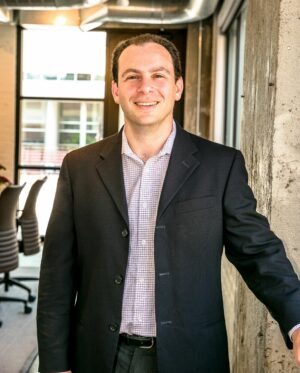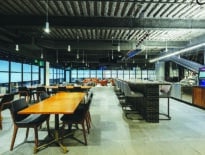Abe Menzin
Principal, Samuels & Assoc.
Age: 43
Industry experience: 20 years
Construction is expected to begin this spring on a landmark project that will change the view for Massachusetts Turnpike commuters and Newbury Street pedestrians alike. Samuels & Assoc.’s Abe Menzin led the design and permitting for the Massachusetts Department of Transportation’s parcel 12 air rights project, which will include a new office building partially leased to CarGurus and a citizenM hotel on a new deck built on the west side of Massachusetts Avenue. Menzin previously oversaw the construction of the mixed-use Van Ness project in the Fenway and the permitting and financing of the 401 Park and 201 Brookline Ave. projects. In January, Menzin was named partner at Samuels after 10 years with the firm.
Q: Air rights projects have been notoriously hard to build in Boston despite decades of attempts by state agencies and developers. What pushed parcel 12 over the finish line?
A: The way we go about planning all of these signature mixed-use projects is pretty similar. We start with planning goals and studying the context. We had dozens of work sessions with Elkus Manfredi Architects. Obviously, we’re very familiar with that neighborhood. We worked out of Newbury Street at our old office, and we were taking trips to Fenway two or three times a day.
Steve [Samuels] describes it as being mesmerized by the potential of that site because it connects several neighborhoods: Fenway and Back Bay, and fixing that stretch of the Mass. Ave. corridor, connecting Cambridge and [the] South End. It was a matter of zooming out, looking at what does the neighborhood need from a transportation perspective, and what kind of uses make sense for the site.
A lot of these air rights projects are a legacy of transportation infrastructure being built in a time when certain modes of transportation were prioritized. Now the transportation has to work for everyone: for the Green Line, buses, bikes and cars. That is really in many ways an infrastructure project with a real estate project above it.
Q: Developers use the phrase “transit-oriented” to describe a wide range of projects. What’s your definition?
A: Transit-oriented development is almost the only thing we do, and it’s the only thing I’ve focused on in my career. The definition of transit is shifting a bit. Obviously this one is right on top of and next to a train station, and part of our effort is to connect the site to the Hynes Convention Center T station with some upgrades.
Transit increasingly is going to be buses if the transportation network is going to become more robust. Bus rapid transit has a tremendous amount of potential. We’ve spent a lot of time with the state and city working on how the buses could work better along this stretch. Cycle tracks used to be striping on asphalt. With this project, we’ve learned how to create protected cycle tracks.
Another idea was creating better bus shelters and enough space to accommodate several buses, so to the extent that bus volumes increase, there will be space. In terms of creative active plaza space, there are great views to the west and people don’t necessarily enjoy them as much now because you’re standing on the edge of a highway. It’ll carve out a multilevel civic space: a park at grade level and monumental stairs with some design elements that pull people up to a plaza on the second floor.
Q: Why was citizenM the best brand for the hotel component?
A: What we love about the hotel is they’re very design-oriented and they do a really good job with their common areas and public spaces. We wanted to move the needle on the sustainability front and the carbon neutrality plan. The hotel will be the first all-electric high-rise in the city, using VRF [variable refrigerant flow] highly-efficient electric heat.
Q: Does Gov. Charlie Baker’s plan to sell the Hynes Convention Center give you second thoughts about the hotel?
A: I don’t think it directly impacts our project. Given the nature of the uses and where they fit into the market, it honestly hasn’t been something we’ve been concerned about. Obviously, the neighborhood has a dialogue on that, but one of the things we love about the neighborhood is there’s so much going on.
Q: What’s a good way to quantify the extra construction costs of air rights project?
A: The premiums of air rights range from the obvious to a higher level of oversight, more robust types of systems that need to be built, to different types of codes and standards near critical infrastructure. We’re not new to working near infrastructure. We’re building and dealing with transportation agencies for years on how to integrate the former Landmark Center into the [Fenway] neighborhood, so a lot of the same things you do to build near railroad lines.
Q: Now that Peebles Corp. is moving forward with its own nearby air rights project on parcel 13, does that affect your timeline for parcel 12?
A: Our project can proceed independently. The state has done a great job of figuring out how to coordinate the projects. It makes sense for them in that there aren’t conflicts between the projects.
Q: How did your earlier jobs lead to your current specialty?
A: I started as an engineer by background coming out of school and focused on large construction projects for a general contractor, working on one of the first green buildings around, out in the suburbs. And I asked my company to put me on urban projects after that. I believe in smart growth, urban infill types of development from a sustainability and transportation perspective. So, I ended up working on projects around Cambridge. At some point I really loved figuring out how to put a complex project together and wanted to understand how owners make decisions, so ended up going back to school and learning the real estate finance and permitting side.
Menzin’s Five Favorite Skating Experiences in Boston:
- The Rink at 401 Park, The Fenway
- Public Garden, Downtown
- Warrior Rink, Brighton
- Turtle Pond, West Roxbury
- Bajko Rink, Hyde Park




 |
| 


